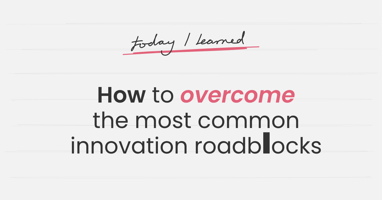An effective innovation process architecture is the foundation on which to build for innovation-led growth. This clear, top-down, leadership establishes the framework for delivering effective innovation management – product planning, innovation portfolio management, new product development (NPD), and the complete lifecycle of ideation and product obsolescence.
The following are four keys pillars that are necessary to establish an effective innovation process architecture:
1. Determine Rules of Governance
Innovation governance is primarily concerned with establishing processes and rules for accountability, responsibility and decision making that will drive effective innovation in an organization. Without this clear accountability it becomes difficult to operate a strategically-guided process, as if your steering-wheel isn't properly connected to your road wheels.
However, there are many other considerations for innovation governance such as roles, responsibilities, prioritization, and managing complex initiatives across multiple functional areas, expertise, participation and contributions with internal and external organizational constituents.
While these rules are needed to clearly define decision making, approvals and empowerment for the innovation process, they should also reflect the innovation aspirations and culture of the business.
2. Defining Lean Innovation Processes
Applying lean principles and leveraging established best practices are key to establishing effective innovation processes. Although most organizations have an established innovation process, they might take a critical look at their performance compared with industry benchmarks to determine where to focus for developing the next generation of processes.
The revised processes must apply the decision-making rigor from the Rules of Governance and mandatory tasks defined by the Innovation Master Data. Within the framework of the rules and master data, it defines the corporate process standards and core minimum requirements that allow parts of the process to vary while maintaining the integrity of the portfolio. This enables increased process adoption in divisions previously resisting a centralized process (common in organizations that have grown by acquisition) while bringing process discipline to hitherto unmanageable numbers of processes accumulated over years of evolutionary growth.
Processes addressed include strategic planning, portfolio management, product innovation (from ideation to market launch) and product range management through to market closure and product obsolescence.
3. Identifying Innovation Master Data
Use an industry model such as Porter's Value Chain and Balanced Scorecards to structured and develop your company's own innovation master data-set.
What are the crucial KPIs that really determine success and drive effective behaviours and decisions?
Ensure that every key area of innovation data is considered and promotes discussion and investigation into the information architecture and data responsibilities in the organization.
Without this clear, data-oriented perspective, the information systems and processes will be prone to rework, miscommunication, duplicate data ownership and ultimately be unable to create portfolio views that can be trusted. The core set of innovation master data establishes what is mandatory within certain types of process and becomes instructive for systems interface definition, because the pillars of the IT architecture need to communicate effectively and no single system owns all the data.
4. The Communications Directive
Formulate the directives for the organization to communicate its innovation strategy with urgency, openness and practical steps for success. This includes a representation of the innovation strategy in the form of targets, timescales and spread of investment so that the operational alignment is tangible, balanced and measurable.
In discussion with the responsible executives for delivering innovation at board level, draft, review, socialize and develop the directive. This document defines leadership responsibilities and accountabilities and sets the business context for all four deliverables. It creates momentum, communicates the innovation culture and demonstrates a leadership and organizational commitment to innovation.
Benefits of Developing an Innovation Process Architecture
- Strategic decision making and operational decisions are connected demonstrably – so your strategy affects the outcome of product portfolio and project gate meetings.
- Innovation management is geared to benefit from best practices and benchmarks in governance, process design, industry standards and the common innovation data masterfile.
- Establishes the four pillars of innovation management: Rules of Governance, Lean Processes, Innovation Master Data, and Communications Directive.
- Embedded portfolio management for business and IT stakeholders – differentiation, consistency and visibility.
- Enhance process adoption by enabling managed process variation and resilient portfolio perspectives.





